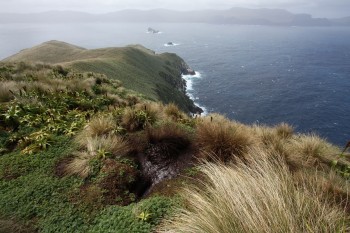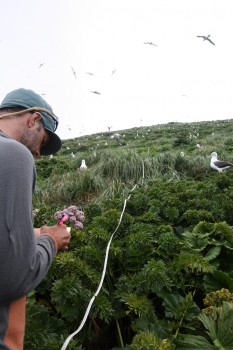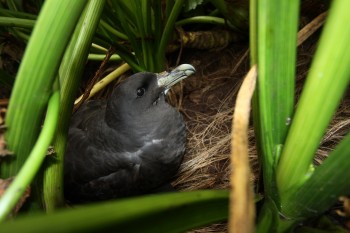In 2014 ACAP made a grant to New Zealand’s National Institute of Water and Atmospheric Research (NIWA) to undertake a population estimate of the White-chinned Petrel Procellaria aequinoctialis on Disappointment Island, Auckland Islands. The field work was carried out over the 2014/15 summer by University of Otago PhD student Kalinka Rexer-Huber (click here), who has now produced a report of the results of her census.

Disappointment Island, photograph by Barry Baker
The report’s summary follows:
“White-chinned petrels Procellaria aequinoctialis are one of the seabird species most affected by fisheries bycatch, yet some populations remain virtually unstudied. The size of the breeding population on the Auckland Islands, New Zealand, is unknown. We estimated the population size of white-chinned petrels on Disappointment Island, thought to be a key breeding site in the Auckland Islands, taking into account the detection probability of burrows via distance sampling and burrow occupancy. Eighty line transects were distributed over the island, with a total line length of 1 600 m. White-chinned petrel burrows occurred at a density of 644 (95% confidence intervals: 487–850) burrows/ha, with an overall burrow detection probability of 0.33 ± 0.03. We document an estimated total of 153 100 (115 900– 202 200) breeding pairs of white-chinned petrels on Disappointment Island in mid incubation.”
With thanks to Kalinka Rexer-Huber.

White-chinned Petrel burrow on Disappointment Island, photograph by Graham Parker

Setting out a line transect, photograph by Graham Parker

Whie-chinned Petrel on Disappointment Island, photograph by Graham Parker
Reference:
Rexer-Huber, K., Parker, G.C., Sagar, P. & Thompson, D. 2015. White-chinned Petrel Population Estimate, Disappointment Island (Auckland Islands). Report to the Agreement for [sic] the Conservation of Albatrosses and Petrels. Dunedin: Parker Conservation. 14 pp.
John Cooper, ACAP Information Officer, 12 June 2015

 English
English  Français
Français  Español
Español